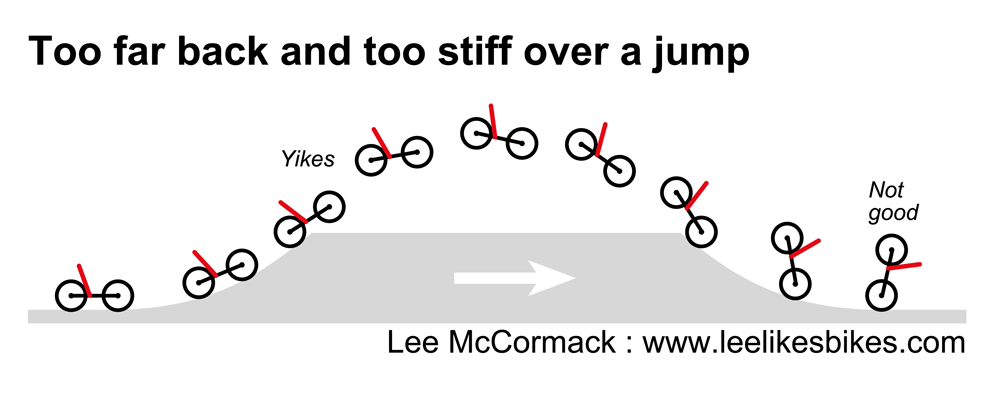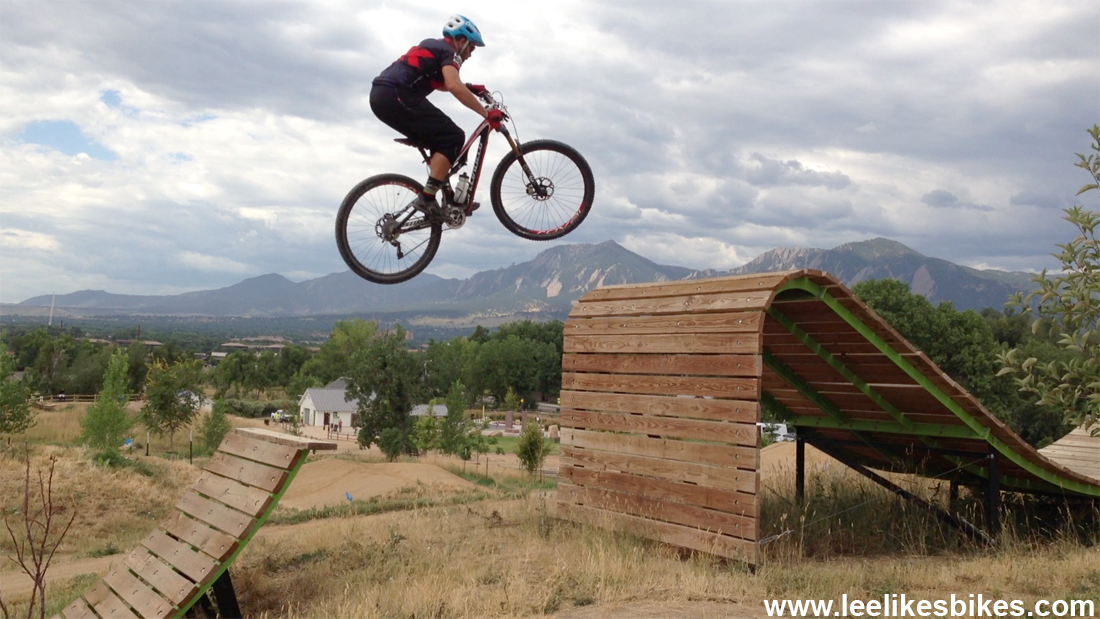Stop the injury cycle!

When bike parks, long-travel bikes and technique errors mix, the results can be gruesome.
If you’re getting hurt a lot, please address the underlying issues. If your friends are getting hurt, try to intervene, but don’t be surprised if your friends don’t want help.

The Whale Tail at Valmont Bike Park is built perfectly with a lot of wiggle room, but I made sure I was going to succeed before I tried it. See Living in the sweet spot.
Warning:
Bike parks and modern bikes are rad for lots of reasons that you probably understand.
But they can be dangerous, and here’s why:
When a jump is built perfectly, as they are at Valmont Bike Park, there’s a lot of leeway for improper technique. You can do something wrong and be OK … until it’s not OK.
When you jump a long-travel bike, it absorbs a lot of your mistakes … until it doesn’t.
These two factors, coupled with unresolved technique errors, can cause real trouble. Riders develop a false sense of ability and bravado. They go bigger and faster. Kinetic energy gets turned to 11. When the mistake is too big for the terrain and bike to absorb, things can go very wrong.
For example:
In the Valmont Bike Park riding family, we have one guy, about my age, who rides the park all the time. He hikes his DH bike to the top of the hill then hits the XL slopestyle. On every run, a fundamental, simple, fixable technique error is there. And his bike absorbs it … most of the time.
As a skills instructor who’s put eyes on something like 5,000 riders, I can see what’s going on, and I understand the potential damage.
I’ve offered to help twice. The first time I said something like, “Hey man, that habit you have is going to hurt you. Take a short class with me, and I’ll fix it.”
No thanks was the non reply.
He kept riding his way — and getting hurt. Shoulder … knee … I wasn’t keeping a list, but I knew he was punishing himself. So I offered to help again, this time without mention of a formal class or even a fee.
No thanks was the non reply.
Last year he posted on Facebook that he’s gonna hit the Banana Peel trail in Winter Park. Banana Peel is big and consequential. If you want to ride it, you have to watch this safety video:
His Facebook post said something like “Stay tuned for video!”
Oh no, I thought.
Then, later that day, hospital photos: shattered pelvis.
Oh my goodness. That’s a bad one. He got through a long recovery, and he’s back on the bike. Valmont riders are coming out of winter hibernation, and this weekend was fantastic.
I was worrying about him Saturday morning, thinking about the whole tangle of technique, mastery, risk and validation. I was thinking I should write a post just like this one — but without this update:
Our friend is back in the hospital. Broken femur at the prosthetic.
Ouch! At this point it’s not an accident; it’s a dangerous, pathological cycle.
To our friend: We hope you heal fast and well. When you’re ready, feel free to reach out. I’ll try to help.
If you’re that guy who keeps getting hurt
Pay more attention to technique. Watch videos. Get coaching (in person or remote). Shoot, spend $20-30 on a book.
Every time you crash, understand why. Fix it.
If you crash a lot, please stop repeating the same behavior. If you add simply speed, amplitude and suspension, it’s going to hurt more when it goes wrong.
If you find yourself compelled to do things that hurt you — over and over — please look at the underlying issues. I know a great therapist who specializes in this sort of thing. Email me at lee@leelikesbikes.com.
But, if you’re really that guy, you won’t see this yourself.
If you ride with that guy
Please intervene. Offer constructive guidance. Suggest a class or video or book. Talk about Life — and the forces that drive us to do stupid $hit. (Yes, I said us.)
You might not be able to help, but you have to try.
No matter who you are, please read this
The most common (and dangerous) mistake in jumping is leaning back on the bike. This loads the rear end and causes the dreaded buck over the bars. Like this:
If you jump with your weight driving into the bottom bracket (and your hands neutral), this will prevent most injuries. Light hands. Heavy feet.
Learn more:
Fore-aft balance when jumping
Shallow vs. steep jumps
Controlling mid-air rotationAdvice for an injury prone dude
Danger: that little aggro voice
Have fun out there. And be safe.
Lee
Know more. Have more fun!
Join the leelikesbikes mailing list:

Leave a Reply
Want to join the discussion?Feel free to contribute!